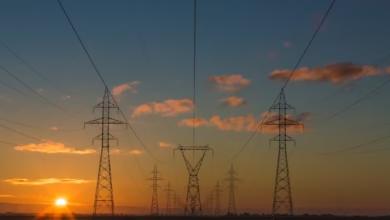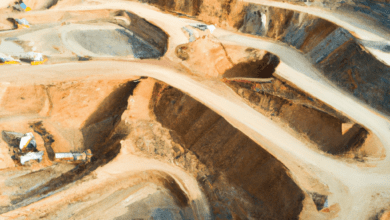Exploring Metal Mining: Sustainable Practices and Investment Trends in Precious and Industrial Metals

Metal mining plays a crucial role in our modern economy, serving as the backbone for countless industries, from construction to aerospace. As demand for both precious metals like gold and silver, and industrial metals such as aluminum, copper, and zinc continues to rise, understanding the intricate processes of exploration, extraction, and production becomes essential. This article delves into the diverse landscape of metal mining, highlighting the journey from the earth's crust to finished products. We will explore the different categories of metals, including ferrous and non-ferrous types, and examine sustainable practices in metal production and recycling, which are vital for minimizing environmental impacts. Additionally, as we look towards the future, we will discuss the emerging trends in investing in metal commodities, particularly focusing on battery metals like lithium and rare earth metals vital for modern technology. Join us as we navigate the complex world of metallurgy, metal alloys, and the evolving market dynamics that shape the future of metal mining.
- 1. Exploring the Landscape of Metal Mining: From Precious to Industrial Metals
- 2. The Extraction Process: Sustainable Practices in Metal Production and Recycling
- 3. Investing in Metal Commodities: Trends in Gold, Silver, and Battery Metals for the Future
1. Exploring the Landscape of Metal Mining: From Precious to Industrial Metals
The landscape of metal mining is vast and diverse, encompassing a wide range of metals essential for various industries. From precious metals like gold and silver, which are often sought after for jewelry and investment purposes, to industrial metals that form the backbone of construction and manufacturing, the exploration, extraction, and production of metals play a critical role in the global economy.
Precious metals, such as gold, platinum, and palladium, are highly valued not only for their rarity but also for their applications in jewelry and investment. Gold investing remains a popular choice for wealth preservation, while silver investing has gained traction due to its industrial applications and the increasing demand for silver in electronics and solar panels.
On the other hand, industrial metals, which include ferrous metals like steel and non-ferrous metals such as aluminum, copper, and zinc, are indispensable in construction, automotive, and aerospace sectors. The demand for these metals is driven by their strength, durability, and versatility. For instance, steel is a fundamental construction metal used in buildings and infrastructure, while aluminum is prized for its lightweight properties, making it ideal for automotive and aerospace applications.
Base metals, including copper and zinc, are critical for various manufacturing processes and metal fabrication. Their ability to form metal alloys enhances their properties, making them suitable for a range of applications from electrical wiring to roofing materials. As industries seek to innovate, the exploration of battery metals like lithium is becoming increasingly important, particularly with the rise of electric vehicles and renewable energy technologies.
Additionally, the mining of rare earth metals, essential for high-tech applications and energy solutions, has gained prominence. These metals are crucial in the production of magnets, batteries, and catalysts, playing a vital role in the advancement of technology and sustainable metal production.
In recent years, metal recycling has emerged as a crucial practice to mitigate the environmental impact of metal mining and reduce metal corrosion. By recycling metals, industries can conserve resources and energy, contributing to sustainable practices while minimizing waste.
As we look to the future, several metal trends, including the rise of 3D printing metals, are influencing the mining landscape. This innovative approach allows for the fabrication of complex metal parts with precision, opening new avenues for production and reducing material waste.
In conclusion, the exploration and production of metals encompass a broad spectrum, from precious to industrial applications. Understanding the dynamics of metal mining, the importance of sustainable practices, and the evolving trends in metallurgy is essential for stakeholders aiming to navigate this ever-changing landscape.
2. The Extraction Process: Sustainable Practices in Metal Production and Recycling
The extraction process of metals has evolved significantly over the years, especially as the demand for sustainable practices in metal production has increased. Today, the industry is focusing on minimizing environmental impacts while ensuring efficient and responsible extraction of various metals, including precious metals, ferrous metals, and non-ferrous metals.
Sustainable metal production begins with the exploration phase, where geologists and mining engineers assess the viability of mining sites. This phase often includes evaluating the presence of rare earth metals and base metals, which are crucial for various applications, from electronics to renewable energy technologies. Once a site is deemed suitable, the extraction process can commence, employing methods that reduce waste and energy consumption.
One of the key sustainable practices in metal extraction is the implementation of efficient metallurgy techniques that maximize yield while minimizing damage to the environment. For instance, advancements in metal fabrication and processing allow for the recovery of metals such as aluminum, copper, and zinc with less energy input. Additionally, the use of eco-friendly solvents and chemicals in the extraction process helps mitigate metal corrosion and reduces harmful emissions.
Metal recycling plays a vital role in sustainable practices, allowing for the recovery of valuable materials from discarded products. The recycling of metals, particularly precious metals like gold and silver, and industrial metals such as steel and aluminum, not only conserves resources but also reduces the carbon footprint associated with mining new materials. With the rise of battery metals like lithium and cobalt, recycling programs are increasingly important in meeting the growing demand for electric vehicle components and renewable energy storage solutions.
Furthermore, as metal trends shift towards more sustainable practices, industries are beginning to embrace innovative technologies like 3D printing. This allows for the creation of metal alloys and components with reduced waste, making it an attractive option for sectors such as aerospace and automotive manufacturing. By using recycled metals in these processes, companies can further enhance sustainability while producing high-quality construction metals and jewelry metals.
In conclusion, the extraction process in metal mining is witnessing a transformative shift toward sustainability. By embracing responsible practices, investing in recycling, and leveraging technological advancements, the industry can ensure a more sustainable future for metal commodities while meeting the demands of modern society.
3. Investing in Metal Commodities: Trends in Gold, Silver, and Battery Metals for the Future
Investing in metal commodities has gained significant attention as economies worldwide pivot towards sustainability and technological advancements. As we look to the future, trends in precious metals like gold and silver, as well as emerging battery metals, will shape investment strategies.
Gold investing remains a cornerstone for many investors, often viewed as a safe haven during economic uncertainty. Its intrinsic value and historical significance as a store of wealth make it a preferred choice among precious metals. Similarly, silver investing offers not only a hedge against inflation but also serves as an industrial metal, essential for applications in electronics and solar panels. The dual nature of silver as both a precious and industrial metal positions it uniquely within the market.
In recent years, battery metals have surged in popularity due to the growing demand for electric vehicles (EVs) and renewable energy storage solutions. Lithium, cobalt, and nickel are vital for battery production, driving investment in these energy metals. As the automotive industry transitions to electric power, the need for non-ferrous metals like aluminum and copper will also increase, highlighting the importance of sustainable metal production practices.
Moreover, the rise of metal recycling has become crucial in the realm of sustainable metal production. Recycled metals not only reduce the need for new mining but also minimize metal corrosion and waste, making it an environmentally friendly option. With advancements in metallurgy and metal fabrication, recycled materials are increasingly utilized in construction metals, aerospace metals, and even jewelry metals, reflecting a broader trend toward circular economies.
As innovations like 3D printing metals emerge, they offer exciting possibilities for the manufacture of metal alloys and refractory metals. These technologies could drastically change how we approach metal mining and production, making it more efficient and sustainable while meeting the growing demands of various sectors, including construction, automotive, and aerospace.
Overall, the landscape of metal commodities is evolving, driven by trends in precious and industrial metals, the rise of battery metals, and a commitment to sustainable practices. Investors who stay informed about these developments will be better equipped to navigate the complexities of the metal market and capitalize on emerging opportunities.
In conclusion, the world of metal mining is vast and multifaceted, encompassing everything from the exploration of precious and industrial metals to the sustainable practices in extraction and recycling. As we have explored, the landscape of metal mining is not just limited to traditional materials like gold and silver; it also includes an increasing focus on battery metals, rare earth metals, and the essential role of base metals such as copper, aluminum, and zinc in modern industries.
Investing in metal commodities, particularly in the context of gold investing and silver investing, remains a vital strategy for those looking to capitalize on market trends. Moreover, the integration of sustainable metal production methods and metal recycling is crucial for minimizing environmental impact and ensuring a more responsible approach to metallurgy.
As technologies advance, including innovations in 3D printing metals and metal fabrication, we can expect to see new applications for aerospace, automotive, and construction metals. The future of metal mining is also intertwined with the ongoing evolution of metal alloys and the fight against metal corrosion, making it an exciting field to watch.
Ultimately, understanding these trends not only equips investors and industry professionals with the insights needed to navigate the metal commodities market but also highlights the importance of sustainable practices in preserving our planet's resources. As we move forward, the commitment to responsible metal mining and production will be essential in meeting global demands while protecting our environment for future generations.
References:
(Include your references here following APA format)





